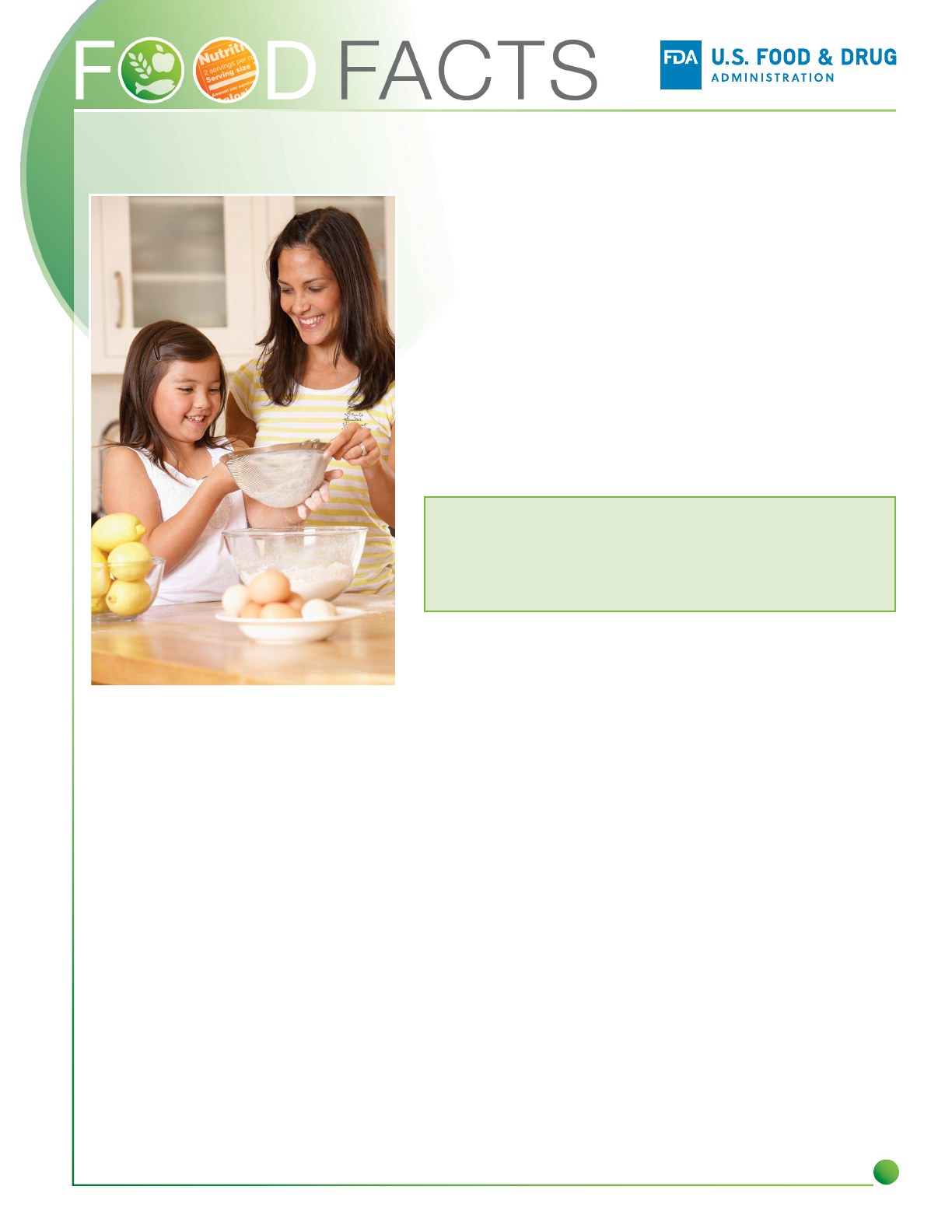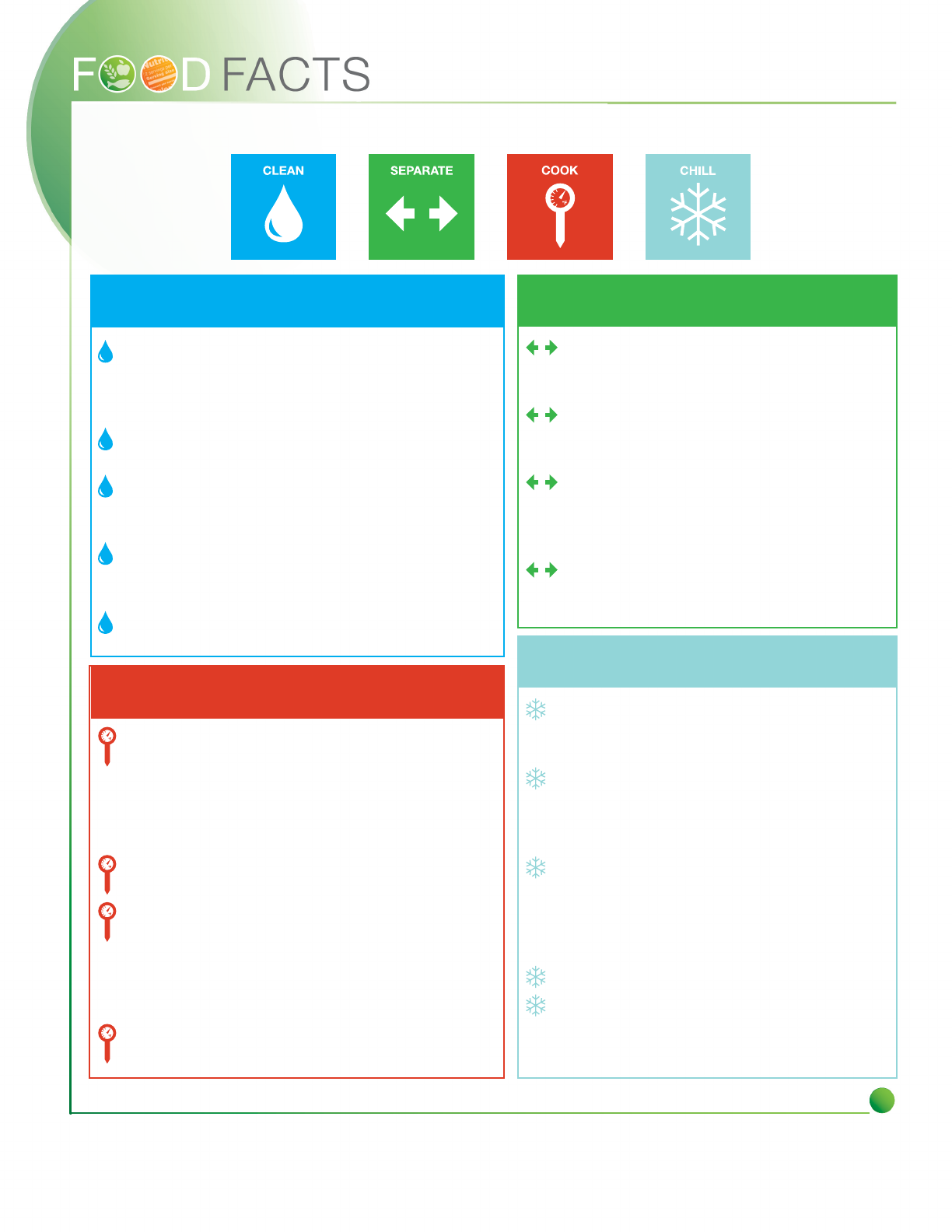
January 2022
1
Handling Flour Safely: What You Need to Know
Protect yourself and your family
by following these safety tips
when preparing foods that
contain our.
Flour is a raw food. It may not look like a raw food, but it usually
is, just like fresh tomatoes or carrots. The grains from which flour
is ground are grown in fields and, like all foods grown outdoors,
they may be exposed to a variety of harmful bacteria like
Salmonella and pathogenic E. coli. The important things to know
are:
• Flours most commonly used in home baking and cooking are
made directly from raw grains.
• Processing these grains into our does not kill harmful bacteria.
• Many foods made with our also contain raw eggs, which may
contain harmful bacteria.
• Cooking is the only way to be sure that foods made with our
and raw eggs are safe.
• Never eat or taste raw our, dough, or batter.
OUTBREAK
Since 2009 there have been several outbreaks of foodborne
illness involving raw flour or raw flour-containing products like
cake mixes and cookie dough. These have resulted in 168
known illnesses and 20 hospitalizations.
Dos and Don’ts for Consumers
• Don’t eat or allow children to eat or play with raw dough products
made with any brand of our or baking mix before cooking.
• Do follow package directions on baking mixes and other our-
containing products for correct cooking temperatures and
specied times.
• If you have any recalled our at home, throw it away.
• Don’t let children use raw dough for crafts/play clay.
• Do keep all raw foods like our and eggs separate from ready-to-
eat foods. Remember, our is a powder and spreads easily.
• Don’t use products that contain raw our, like cake mix to make
milkshakes.
• Don’t try to heat treat our in your own home.
• Don’t use raw cookie dough in ice cream (the cookie dough in ice
cream sold in stores has been treated to kill harmful bacteria).
• Do refrigerate cookie and pastry dough according to package
directions. Use a refrigerator thermometer to be sure your
refrigerator is at a safe 40°F.
• Do clean up carefully after working with our or raw dough and
eggs:
o Wash hands thoroughly with soap and running water, and,
o Wash utensils, bowls, baking pans, cutting boards, and
countertops with warm, soapy water.

January 2022
Safe Food Handling: Four Simple Steps
CLEAN
Wash hands and surfaces often
Wash your hands with warm water and soap for at least
20 seconds before and after handling food and after
using the bathroom, changing diapers, and handling
pets.
Wash your cutting boards, dishes, utensils, and counter
tops with hot soapy water after preparing each food item.
Consider using paper towels to clean up kitchen
surfaces. If you use cloth towels, launder them often in
the hot cycle.
Rinse fresh fruits and vegetables under running tap
water, including those with skins and rinds that are not
eaten. Scrub rm produce with a clean produce brush.
With canned goods, remember to clean lids before
opening.
SEPARATE
Separate raw meats from other foods
Separate raw meat, poultry, seafood, and eggs
from other foods in your grocery shopping cart,
grocery bags, and refrigerator.
Use one cutting board for fresh produce and
a separate one for raw meat, poultry, and
seafood.
Never place cooked food on a plate that
previously held raw meat, poultry, seafood, or
eggs unless the plate has been washed in hot,
soapy water.
Don’t reuse marinades used on raw foods
unless you bring them to a boil rst.
COOK
Cook to the right temperature
Color and texture are unreliable indicators of safety.
Using a food thermometer is the only way to ensure the
safety of meat, poultry, seafood, and egg products for
all cooking methods. These foods must be cooked to a
safe minimum internal temperature to destroy any
harmful bacteria.
Cook eggs until the yolk and white are rm. Only use
recipes in which eggs are cooked or heated thoroughly.
When cooking in a microwave oven, cover food, stir,
and rotate for even cooking. If there is no turntable,
rotate the dish by hand once or twice during cooking.
Always allow standing time, which completes the
cooking, before checking the internal temperature with
a food thermometer.
Bring sauces, soups and gravy to a boil when reheating.
CHILL
Refrigerate foods promptly
Use an appliance thermometer to be sure the
temperature is consistently 40° F or below and
the freezer temperature is 0° F or below.
Refrigerate or freeze meat, poultry, eggs, seafood,
and other perishables within 2 hours of cooking
or purchasing. Refrigerate within 1 hour if the
temperature outside is above 90° F.
Never thaw food at room temperature, such as
on the counter top. There are three safe ways to
defrost food: in the refrigerator, in cold water, and
in the microwave. Food thawed in cold water or in
the microwave should be cooked immediately.
Always marinate food in the refrigerator.
Divide large amounts of leftovers into shallow
containers for quicker cooling in the refrigerator.
2
For more information, contact the U.S. Food and Drug Administration, Center for Food Safety and Applied Nutrition’s Food and
Cosmetic Information Center at 1-888-SAFEFOOD (toll free), Monday through Friday 10 AM to 4 PM ET (except Thursdays from
12:30 PM to 1:30 PM ET and Federal holidays). Or, visit the FDA website at http://www.fda.gov/educationresourcelibrary
